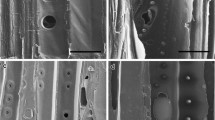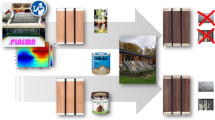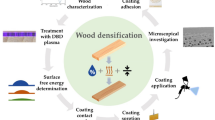Abstract
In order to provide a database which documents the influence of plasma treatment on water uptake of wood veneers, veneers of 27 wood species underwent immersion tests in untreated and plasma-treated states. Plasma treatment was executed using an air driven dielectric barrier discharge at atmospheric pressure. The results showed that plasma treatment led to significantly improved water uptake for most of the wood species, but some wood species remained unaffected after plasma treatment.
Similar content being viewed by others
Explore related subjects
Discover the latest articles, news and stories from top researchers in related subjects.Avoid common mistakes on your manuscript.
1 Introduction
In recent years many studies have been published on plasma treatment of wooden materials. In most cases, the goals of these studies were either to improve surface wettability for the purpose of enhancing the adhesion coatings or adhesives, or to furnish the surfaces with protective layers or water repellent properties (Viöl et al. 2012). An additional use of plasma treatment in the wood-processing industry involves the improvement of liquid uptake in the modification of wooden materials.
The modification and/or impregnation of wood are often achieved by water soluble agents (e.g., DMDHEU, melamine, phenolic resins, and acetic anhydride) (Rowell 2012). Furthermore, the curing of water-based coatings and adhesives such as polyvinyl acetate (PVAc) is influenced by the extraction of water. Since the curing time and the velocity of solution uptake are crucial parameters in wood processing, methods that accelerate these parameters are desirable.
Wolkenhauer et al. (2007) have demonstrated in immersion tests that the water uptake of thin (3 mm) particle board and fibreboard can be significantly improved by plasma treatment. Haase and Evans (2010) have shown that the penetration depths of adhesives can be increased by plasma pre-treatment of black spruce. Avramidis et al. (2010) have shown that the uptake of waterborne DMDHEU-solution and melamine-solution in DBD-treated beech veneers or thermally treated beech veneers can be significantly accelerated. However, it has also turned out that the influence of plasma treatment on wettability and enhanced liquid uptake is dependent on the wood species (Avramidis et al. 2010). Therefore the objective of this study was to prepare a database which documents the influence of plasma treatment on various wood species with regard to the enhanced liquid uptake of their veneers. To determine this susceptibility, veneer samples of 27 wood species in both untreated and plasma treated states were subjected to air-driven dielectric barrier discharge (DBD) treatment at atmospheric pressure.
2 Materials and methods
Sliced veneers of 27 wood species - consisting of 15 (sub)tropical species and 12 species native to moderate latitudes - were used for the tests. Additionally, veneers of Quercus spec. subfossil were tested, so that overall 28 types of veneers were investigated.
The veneer sheets were cut to samples of 50 × 50 mm2 (thickness of 0.4–1.0 mm) and were stored (72 h) at 20 °C and 65 % RH (standardized climate, DIN 50 014) prior to treatment. The setup and operating conditions used are described in Avramidis et al. (2010). Using this setup the veneers were plasma treated on both sides simultaneously. The applied alternating voltage was ~23 kV (peak) and the injected power of the discharge in the gap was 180 W. The treatment duration was 60 s. Gas temperatures during plasma treatment were measured with a fibre-optical thermometer (FTI-10, FISO Technologies, Sainte-Foy, Canada) and did not exceed 70 °C, so that minimal thermal influence can be presumed.
The water uptake of the samples was determined by a simple immersion test at atmospheric pressure and a temperature of 20 °C. The immersion duration was 30 s. Since the cross sections of the veneers were not sealed, the water penetrated via the longitudinally cut surfaces as well as via the cross sections. The samples were weighed before and after immersion in water, and residual water on the surface was removed by a stripper. The percentage of increase in mass (water uptake UW) was calculated according to the following equation (Niemz 1993):
where M1 is the mass before immersion and M2 is the mass after immersion.
The improvement of uptake (UI) of the plasma treated samples compared to the references was calculated by:
where UWtreat is the water uptake of the plasma treated samples and UWref is the water uptake of the untreated samples.
3 Results and discussion
The results of the immersion tests for the 28 types of veneer are given in Table 1. The values were analyzed by two-sample t-test to determine the statistical significance of differences in water uptake between untreated and plasma treated specimens (significance level = 0.05).
Four out of 28 types of veneers showed no significant alteration in water uptake (Dracontomelum dao, Juglans nigra, Pterygota spec., Quercus spec.). Only in the veneers of Picea abies did plasma treatment lead to significantly decreased water uptake. All other types of veneer showed significantly increased water uptake when plasma treated.
No correlation could be detected between improvement of water uptake and diameter of vessels, lumen, pores, original uptake capability, occurrence of cracks, knots or membership in a certain family.
Further in-depth case studies of single wood species or types of wood veneers are necessary in order to reveal factors that make them susceptible to improved water uptake after plasma treatment. A promising approach is given for example by the SEM-studies of Jamali and Evans (2011), which revealed the etching of wood cell walls and notably of pits due to low-pressure H2O-plasma treatment. The etching of pits can open penetration channels, which can lead to improved capillary uptake of liquids.
From these results it can be assumed that most types of veneers might show similar beneficial effects of plasma pre-treatment using water-based systems in applications such as bonding, painting and impregnation.
4 Conclusion
The results demonstrate that plasma treatment of wood veneers can considerably increase the water uptake capability for most of the tested wood species or veneer types. More research is needed to reveal mechanisms of the observed effects of plasma treatment and to evaluate its suitability for applications in wood processing.
References
Avramidis G, Tebbe B, Nothnick E, Militz H, Viöl W, Wolkenhauer A (2010) A wood veneer modification by atmospheric pressure plasma treatment for improved absorption characteristics. In: Hill CAS, Militz H, Andersons B (eds) The fifth European conference on wood modification. Latvian State Institute of Wood Chemistry, Riga, pp 365–372
Haase JG, Evans PD (2010) Plasma modification of wood surfaces to improve the performance of clear coatings. In: Hill CAS, Militz H, Andersons B (eds) The fifth European conference on wood modification. Latvian State Inst of Wood Chemistry, Riga, pp 271–274
Jamali A, Evans PD (2011) Etching of wood surfaces by glow discharge plasma. Wood Sci Technol 45(1):169–182
Niemz P (1993) Physik des Holzes und der Holzwerkstoffe. DRW-Verlag, Leinfelden-Echterdingen
Rowell RM (2012) Handbook of wood chemistry and wood composites. Taylor & Francis, Boca Raton
Viöl W, Avramidis G, Militz H (2012) Plasma treatment of wood. In: Rowell RM (ed) Handbook of wood chemistry and wood composites, 2nd edn. Taylor & Francis, Boca Raton, pp 627–658
Wolkenhauer A, Avramidis G, Militz H, Viöl W (2007) Wood modification by atmospheric pressure plasma treatment. In: Hill CAS, Jones D, Militz H, Ormondroyd GA (eds) The third European conference on wood modification. Biocomposites Centre University of Wales, Bangor, pp 271–274
Acknowledgments
This work was funded by the German Federal Ministry of Education and Research (BMBF), under the supervision of Dr.-Ing. Karen Otten, in Jülich, Germany and the joint research project “PlaNaWood” (Grant No. 03X5519B).
Author information
Authors and Affiliations
Corresponding author
Rights and permissions
About this article
Cite this article
Wascher, R., Schulze, N., Avramidis, G. et al. Increasing the water uptake of wood veneers through plasma treatment at atmospheric pressure. Eur. J. Wood Prod. 72, 685–687 (2014). https://doi.org/10.1007/s00107-014-0815-7
Received:
Published:
Issue Date:
DOI: https://doi.org/10.1007/s00107-014-0815-7




